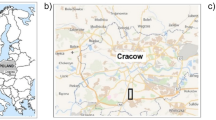Summary
We evaluated potential NO sup-inf3 losses from organic and inorganic N sources applied to improve the growth of cotton (Gossypium hirsutum) on a Pima clay loam soil (Typic Torrifluvent). An initial set of soil cores (April 1989) was collected to a depth of 270 cm from sites in a cotton field previously amended with anaerobically digested sewage sludge or an inorganic N fertilizer. The denitrification potential was estimated in all soil samples by measuring N2O with gas chromatography. Soils amended with a low or high rate of sludge showed increased denitrification activity over soil samples amended with a low rate or inorganic N fertilizer. All amended samples showed greater denitrification activity than control soils. The denitrification decreased with soil depth in all treatments, and was only evident as deep as 90 cm in the soils treated with the high sludge rate. However, when soils collected from depths greater than 90 cm were amended with a C substrate, significant denitrification activity occurred. These date imply that organisms capable of denitrification were present in all soil samples, even those at depths far beneath the root zone. Hence, denitrification was C-substrate limited. A second series of soil cores taken later in the growing season (July 1989) confirmed these data. Denitrification losses (under laboratory conditions) to a soil depth of 270 cm represented 1–4% of total soil N depending on treatment, when the activity was C-substrate limited. With additional C substrate, the denitrification losses increased to 15–22% of the total soil N.
Similar content being viewed by others
References
Artiola JF (1991) Nonuniform leaching of nitrate and other solutes in a furrow-irrigated, sludge amended field. Commun Soil Sci Plant Anal 22:1013–1030
Blackmer AM, Bremmer JM (1976) Nitrogen isotope discrimination in denitrification of nitrate in soils. Soil Biol Biochem 9:73–77
Chen RL, Patrick WH (1981) Efficiency of nitrate removal in a simulated overland flow waste water treatment system. J Environ Qual 10:98–103
Christensen S (1983) Nitrous oxide emission from soil under permanent grass: Seasonal and diurnal fluctuations and influences by manuring and fertilization. Soil Biol Biochem 15:531–536
Enfield CG (1977) Serve-controlled optimization of nitrification-denitrification of wastewater in soil. J Environ Qual 6:456–458
Gilbert RG, Lance JC, Miller JB (1979) Denitrifying bacteria populations and nitrogen removal in soil colums intermittently flooded with secondary sewage effluent. J Environ Qual 8:101–104
Hsieh YP, Douglas LA, Motto HL (1981) Modeling sewage sludge decomposition: II. Nitrogen transformations. J Environ Qual 10:59–67
Lindemann WC, Cardenas M (1984) Nitrogen mineralization potential and nitrogen transformations of sludge-amended soil. Soil Sci Soc Am J 48:1072–1077
Lindemann WC, Connell G, Urquhart NS (1988) Previous sludge addition effects on nitrogen mineralization in freshly amended soil. Soil Sci Soc Am J 52:109–112
Mills JG, Zwarich MA (1982) Movement and loss of nitrate heavy applications of sewage sludge to a poorly drained soil. Can J Soil Sci 62:249–257
Reid M (1990) Nitrate potential from sludge and inorganic fertilizer in soil leachate beneath an irrigated agricultural field. MS thesis, University of Arizona, Tucson, Arizona
Rice CW, Sierzega PE, Tiedje JM, Jacobs LW (1988) Stimulated denitrification in the microenvironment of a biodegradable organic waste injected into soil. Soil Sci Soc Am J 52:102–108
Rolston DE, Broadbend FE, Goldhamer DA (1979) Field measurement of denitrification: II. Mass balance and sampling uncertainty. Soil Sci Soc Am J 43:703–708
Spalding RF, Kitchen LA (1988) Nitrate in the intermediate vadose zone beneath irrigated cropland. GWMR, Spring 89–95
Tiedje JM (1982) In: Page AL, Miller RH, Keeney DR (eds) Methods of soil analysis Part 2, Chemical and microbiological properties, 2nd edn. Am Soc Agron, Madison, Wisconsin, Chapter 47. Denitrification, 14 pp
Tiedje JM (1988) Ecology of denitrification and dissimilatory nitrate reduction to ammonium. In: Zehnder ASB (ed) Biology of anaerobic microorganisms. John Wiley, New York, pp 179–243
Volz MG, Heichel GH (1979) Nitrogen transformations and microbial population dynamics in soil amended with fermentation residue. J Environ Qual 8:434–439
Webster CP, Dowdell RJ (1982) Nitrous oxide emission from permanent grass swards. J Sci Food Agric 33:227–230
Westerman RL, Tucker TC (1978) Factors affecting denitrification in a Sonoran Desert soil. Soil Sci Soc Am J 42:596–599
Author information
Authors and Affiliations
Rights and permissions
About this article
Cite this article
Artiola, J.F., Pepper, I.L. Denitrification activity in the root zone of a sludge-amended desert soil. Biol Fertil Soils 13, 200–205 (1992). https://doi.org/10.1007/BF00340576
Received:
Issue Date:
DOI: https://doi.org/10.1007/BF00340576




